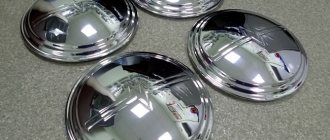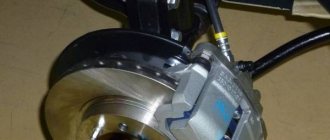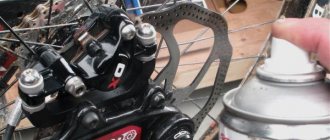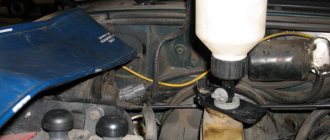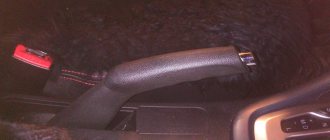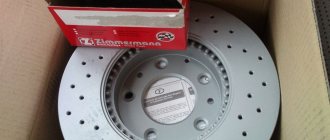Drum brakes
It is believed that drum brakes were the first to appear - on horse-drawn carts, and they migrated to cars from carriages, and at first only to the rear axle. For a long time, all cars were equipped only with drum brakes, although disc brakes were patented by the Englishman William Lanchester in 1902. And in the same year, the Frenchman Louis Renault presented his design of a brake mechanism - with a hollow drum and semicircular pads, pressed by a cylinder and springs to the inner surface of the drum.
It is interesting that Renault’s design has survived to this day practically unchanged, with the exception that there can now be a pair of cylinders, and spacer bars have appeared that provide self-feeding. Previously, we had to install the pads ourselves; this procedure was familiar to our grandfathers.
The design of drum brakes turned out to be so well thought out that they have remained virtually unchanged over the past century. Perhaps that's why Renault is in no hurry to abandon drums.
We advise you to read our articles
Food and alcohol: a list of dangerous dishes for the driver
How to rent a car in a taxi and not “get money”
How to change a tire without a jack?
Lada XRAY Cross with CVT
Today there seem to be no cars left with front drum brakes at all. And they hold tightly to the rear axle - they can still be seen on some passenger cars, primarily so-called public sector cars. It is believed that drum brakes are cheaper than disc brakes, but this is a controversial statement.
Design and principle of operation of disc brakes
The design of disc brakes is clearly shown in the figure above. Just like in a drum brake, the element to which the braking force is applied - the disc - is rigidly mounted on the wheel hub and has a common axis of rotation with it. But, unlike a drum brake, in a disc brake the force is applied not to the end surface, but to the side surfaces of the brake disc.
A caliper is attached to a part that is stationary relative to the rotating wheel - a device for placing a working hydraulic cylinder and brake linings, and moving the latter along guides in a given range.
The pads are located on both sides relative to the plane of rotation of the disk and, as if with pliers, clamp it when braking. The following figure shows a simplified diagram of heat generation and dissipation in disc brakes.
Unlike drum brakes, heat flows here are directed in the opposite direction, and heat is dissipated directly into the environment. For more efficient heat dissipation, a pattern of grooves and through holes are created on the surface of the brake discs.
The materials from which the working surfaces of disc brakes are made are similar to those for drum brakes. But, due to greater load, they must meet more stringent requirements for physical and mechanical characteristics.
The operation of disc brakes is clearly shown in the video at the end of the article. Also, the authors of the video, using professional technical means, compared the effectiveness of drum and disc brake mechanisms.
However, drums have several undeniable advantages:
Good protection against dirt. Since brake pads, springs, hydraulic cylinders and spacers are hidden in the drum, dirt, snow, and ice have virtually no effect on the performance of the mechanism. Because of this, drum brakes are considered more suitable for heavy-duty applications.
An impressive resource. Brake pads have a large working surface and a large working part of the drum.
Easy combination with the parking brake mechanism.
Drum brake parts.
Drum brake mechanism
We have already said that disc brakes were invented earlier, but drum brakes have become more widespread and are still used today. Why? Probably because it turned out to be easier to implement them on cars and carts. After all, there simply weren’t any complex parts in a drum brake “a la the 19th century,” and the industry of that time couldn’t produce them.
The prototype of drum brakes was a system of three elements: a drum that was rigidly attached to the wheel, a flexible and durable band around the drum, and a lever that pulled the band. Of course, such brakes served very little, the band quickly wore out, and so did the drum, especially since dirt, stones, etc. got under the band. This continued until 1902. It was this year that the genius of the automotive industry, Louis Renault, proposed a version of drum brakes in which the braking elements (pads) were “hidden” inside the drum. The entry of dirt into the brake mechanism was excluded and, accordingly, the service life increased.
Of course, over time, new materials and new principles for driving the brake system appeared, but the principle of operation itself remained unchanged.
The drum brake is designed to change the speed of the car, and if it is used on the rear wheels, then to implement the parking brake.
Basic elements of a drum brake:
- The brake drum is made of high-strength cast iron with a circularly ground internal surface. It is installed on the wheel hub or on the support shaft, in which case the wheel bearing is pressed directly into the drum.
- Brake pads are crescent-shaped metal elements with asbestos-based friction linings attached to the working surface. One of the pads houses the parking brake lever.
- Brake hydraulic cylinder(s), which is a cast iron body, inside of which there are working pistons (on both sides). The pistons are equipped with sealing collars that prevent brake fluid from leaking during the working stroke. To remove air from the system, a bleed valve is screwed into the housing.
- Coupling springs, which work in compression, are attached to the pads at the top and bottom, preventing the pads from moving apart in different directions during “idling”.
- The protective disc is installed directly on the hub or on the rear beam. The brake cylinder and pads are movably attached to the disc using spring-loaded clamps.
- The latch is a metal rod on which a block-plate-spring-plate is installed in a “sandwich” manner. Thus, the pad is pressed against the disc, but at the same time can move freely in a vertical plane.
- The block spacer is a metal plate with special cutouts. Installed between the pads in systems where one brake cylinder is used. The spacer is intended for installing the self-drive mechanism, as well as for actuating the second block when pulling the parking brake lever.
- The self-feeding mechanism is designed to move worn brake pads closer to the working surface of the drum. This can be a spring-loaded wedge, which, as the friction linings wear out, sinks deeper between the spacer and the block, preventing the latter from moving far from the working surface of the drum. This simple self-propelling mechanism was used by Volkswagen designers. Ford introduced a more complex, but less reliable system - a metal strip with a “tooth” is installed on the spacer, and when you press the brake pedal sharply, a special corner lifts the plate up. The “tooth” rotates the ribbed nut into which the spacer elements are screwed, thereby bringing the pads closer to the drum. There are other self-supply systems, but we will not dwell on them.
- The shoe supply mechanism was used in older generation cars, such as Zhiguli. It consists of two eccentrics in the body of the protective disk. By rotating the eccentrics that are adjacent to the block, they achieve a tighter fit to the drum.
The drum system works as follows: the driver, by pressing the brake pedal, creates pressure in the working fluid system. The brake fluid “presses” on the pistons of the brake cylinder. Overcoming the force of the tension springs, the pistons activate the brake pads, which diverge on the sides, tightly adjacent to the working surface of the drum, slowing down the speed of rotation of the drum together with the wheel disk. In our case, one cylinder is used, which “presses” on the upper ends of the pads, the lower ends are simply inserted into the stop placed on the protective disk
There is a drum brake system with two cylinders; by the way, the efficiency of such a system is better than that of the first option. In this case, instead of a stop, a second brake cylinder is installed, the contact area between the brake shoe and the drum increases.
| WE RECOMMEND ALSO READ: |
Share
Share
Disadvantages of drum brakes:
Considerable weight.
Poor cooling. As a result, there is the possibility of overheating under heavy loads.
Poor self-cleaning. If moisture gets inside the drum and ice forms, the brake mechanism will prevent the car from moving. If grains of sand get in, an extraneous sound will appear.
Difficulty monitoring the degree of wear. To evaluate the life of the pads, the drum will have to be removed.
Uneven pad wear. The front tends to wear out faster. Due to improper adjustment or jamming of the mechanism, some part of the block may become unusable faster.
Disc brakes. The wear of the pads can be determined immediately - there is no need to disassemble anything.
How are disc brakes different from drum brakes?
Both types of brakes were invented at approximately the same time (early 20th century) and the replacement of one type by the other occurred gradually as technology developed. In fact, the use of disc brakes has been hampered for decades by the lack of suitable lining material.
Advantages of disc brakes
The main advantages of disc brakes are determined by the lining layout and operating conditions. Counter heat flows in the disc between the linings during braking ensure uniform expansion of the disc material and “pressing” both linings towards it. And direct contact of the disk with the environment ensures effective heat exchange.
- In drum brakes, heat is released into the environment not directly, but through the side surface of the drum. Thermal expansion of this part of the surface occurs with asymmetrical resistance from the external environment: the pad is “pressed” on the inside, but there is no resistance on the outside. Thus, disc brakes are cooled better than drum brakes.
- In addition, changes in the gaps of the working surfaces of disc brakes that occur during the braking process are caused by symmetrical influences and therefore the gaps can self-adjust, while in drum brakes the influences are asymmetrical and therefore additional adjustments are required over time.
- In disc brakes, unlike drum brakes, products from the interaction of rubbing surfaces do not accumulate. These are mechanical particles formed due to wear and gases, which are especially dangerous because, accumulating inside the drum, they are to some extent a lubricant in the gap of the friction pair.
Modern braking systems, in addition to mechanical and hydraulic systems, also include electronic ones (for example, the well-known anti-lock braking system). At the same time, disc brakes are structurally much better suited for interfacing with electronics than drum brakes.
Advantages of drum brakes
In turn, part of the advantages of drum brakes is due to the fact that the friction pair is isolated from environmental influences.
- In disc brakes, after intense braking and the car getting into water, the open brake disc can easily become deformed or thermal cracks may appear in it, leading to destruction. The drum mechanism is more protected in such cases.
- The abrasive particles contained in the dirt that get into the gap between the discs, although they are thrown away by centrifugal forces when the disc rotates, significantly accelerate the wear process of the linings compared to drum brakes.
- In addition, despite the larger number of parts, repairing and replacing drum brakes requires less labor than disc brakes.
Thus, the combined use of different types of braking systems: disc - front, drum - rear for budget cars is quite justified to this day.
basic information
Any car, both small and large, must be equipped with a braking system. The main task of the braking system is to change the speed of movement of vehicles, at the command of the car owner or the electronic guidance system. The second purpose of the braking system is to keep the car stationary in relation to the road while it is parked.
Depending on the design of the friction part, a distinction is made between disc and brake drum mechanisms. The braking mechanism has a fixed and rotating part. The role of the moving part of the drum braking structure is played by the stopping drum, and not by the rotating band or braking pad. The moving part of the brake disc design has the form of a disk, and is not rotated by the brake pads. The axles of modern passenger cars usually have a disc braking structure.
Drum brake diagram
The disc braking mechanism consists of the following elements:
- Brake disc;
- Two non-rotating pads that are installed in the middle of the caliper on both sides.
Let's look at the main advantages and disadvantages of drum and disc brakes. So, the advantages of drum brakes:
- Long service life, since dirt and dust do not penetrate into the drum;
- Greater braking effort, which is good for trucks;
- Not an expensive repair kit.
Disadvantages include:
- Slowness;
- Pads sticking.
Advantages of disc brakes:
- Greater braking efficiency;
- Small mass;
- Small sizes;
- Low brake fluid temperature;
- High level of reliability;
- Stability.
The only drawback is poor protection from dirt and dust.
What is the principle of operation of the braking system?
Let's look at the principle of operation of the braking system using the example of a hydraulic operating unit. When the brake is pressed, the load is transferred to the amplifier, which creates additional reinforcement on the main cylinder. The piston of the main brake cylinder collects all the fluid in the car wheel cylinders using pipelines. Moreover, at the same moment, the fluid pressure in the brake drive increases. Thanks to the pistons of the car wheel cylinders, the brake pads move to the discs, or as they are also called drums.
After pressing the brake, the fluid pressure increases, as a result of which the braking mechanisms are activated, causing the rotation of the car wheels to slow down and generate braking force at the point of contact of the car tires with the road surface.
Moreover, the more force is applied to the brake pedal, the more efficiently and quickly the car wheels will stop. The liquid pressure at the moment of stopping can reach from ten to fifteen megapascals.
At the end of braking, the pedal moves to the reverse position under the influence of the return spring. The piston of the main braking cylinder also switches to the reverse position. Parts of the springs are retracted from the drums using blocks. Brake fluid passes into the main braking cylinder from the car wheel cylinders thanks to pipelines. Thus, the pressure of the braking system decreases.
Drum brakes squeak
To eliminate the squeaking of rear drum brakes, you need to purchase a suitable repair kit. So, what repair kit should you buy if your drum brakes squeak?
- Anti-recoil struts;
- Set of socket heads;
- Coarse-grained skin;
- Hammer;
- Balloon wrench;
- Torque wrench;
- Screwdriver;
- Support stands;
- Jack.
So, what should you do if your drum brakes squeak?
- First of all, prepare the repair kit;
- Place the car on a flat surface and remove the parking brake;
- Place wheel chocks under the car wheels;
- Loosen the bolts securing the car wheels;
- Place the car on a jack;
- Remove the wheel;
- Carefully remove the protective cap that covers the wheel bearing. To do this you will need a screwdriver and a hammer.
- Unscrew the nut that secures the drum;
- Remove the drum;
- Using coarse sandpaper, remove the edge created by the functioning of the pads;
- Clean the drum from rust;
- Install everything in reverse order. Use a torque wrench when tightening the bearings.
- Check if the rear brakes are squealing.
We recommend: Which is better: distributed injection or direct?
Algorithm for replacing rear drum brakes with disc brakes
Before you proceed to replacing the rear drum brakes, you need to purchase a repair kit. So, how do you replace brakes with disc brakes?
- First, we prepare the repair kit;
- Raise the back side of the car on a jack;
- Remove the corresponding wheel;
- Release the handbrake;
- Mark the location of the drum and hubs;
- Insert 2 screwdrivers into the holes of the brake flap;
- We clean the brakes using a special fluid;
- Remove the return spring from above in front of the block;
- Remove the spring plate that secures the block. To do this, you need to press the plate and rotate it ninety degrees.
- Remove the block and the adjusting bar;
- Disconnect the handbrake cable from the rear shoe lever;
- Remove the adjusting bar spring;
- Disconnect the return spring;
- Remove the adjusting bar;
- Remove the bracket that secures the pad;
- Remove the adjusting lever;
- Remove the handbrake lever;
- We install new parts, doing everything in reverse order;
- We install the wheel on the vehicle.
Story
The modern drum brake was invented in 1902 by Louis Renault, although less complex designs had been used by Maybach the year before. In early brakes, the pads were pressed mechanically using levers and cables. From the mid-1930s, small brake cylinders with pistons began to be installed, although some vehicles continued to use mechanical braking systems throughout subsequent decades. Sometimes two brake cylinders were installed.
The pads in the drum are subject to heavy wear, and early brakes had to be adjusted regularly until the invention of self-adjusting drum brakes in the 1950s. In the 1960s and 1970s, all modern cars installed disc brakes on the front wheels, while drum brakes were still installed at the rear, although some manufacturers installed disc brakes on all four wheels. Drum brakes are also used in conjunction with a hand brake, as it has proven very difficult to design a hand brake for a disc system.
The first brake pads had asbestos linings, so care must be taken when working on older cars to avoid inhaling dust. The US government began to regulate asbestos production, and brake manufacturers had to switch to non-asbestos linings. At first, many drivers complained about deterioration in braking, but this was later compensated for by the development and improvement of technology, which made it possible to completely abandon asbestos linings. Other countries have also restricted the use of asbestos in brakes.


